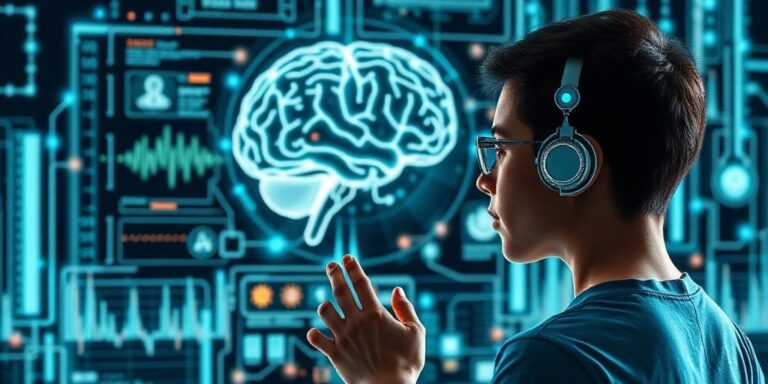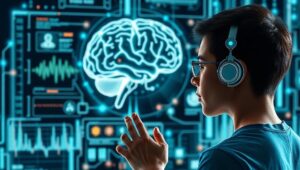Creating Software for Brain-Computer Interfaces (BCIs) (2030+)
Brain-computer interfaces (BCIs) are poised to revolutionize how we interact with technology. By the 2030s, we can expect significant advancements in both the hardware and software components of these systems. This post explores the key aspects of developing software for next-generation BCIs.
Understanding the BCI Landscape
Before diving into software specifics, it’s important to understand the BCI ecosystem. A typical BCI system involves:
- Sensors: Devices that detect brain activity (e.g., EEG electrodes, implanted sensors).
- Signal Processing: Algorithms to filter and amplify relevant brain signals.
- Feature Extraction: Identifying key patterns in the processed signals.
- Translation Algorithm: Mapping extracted features to device commands.
- Output Device: The technology being controlled (e.g., a cursor on a screen, a robotic arm).
Software development plays a crucial role in signal processing, feature extraction, and translation algorithms.
Key Software Development Areas
1. Signal Processing and Noise Reduction
Raw brain signals are noisy and complex. Software is needed to:
- Filter out artifacts: Remove noise from muscle movements, eye blinks, and external interference.
- Amplify relevant signals: Enhance the brain signals of interest.
- Implement adaptive filtering: Adjust filtering parameters based on real-time signal characteristics.
Advanced techniques like wavelet transforms, Kalman filtering, and adaptive noise cancellation are crucial in this area.
2. Feature Extraction
This involves identifying patterns in brain signals that can be used to control devices. Software must:
- Identify relevant features: Determine which signal characteristics (e.g., frequency bands, amplitude changes) correlate with specific mental states or commands.
- Implement machine learning algorithms: Train models to recognize these features in real-time.
- Handle non-stationarity: Adapt to changes in brain signal characteristics over time.
Common feature extraction methods include power spectral density analysis, common spatial patterns (CSP), and time-frequency analysis.
3. Translation Algorithms
The core of any BCI system is the algorithm that translates brain activity into device commands. Software in this area must:
- Map features to actions: Create a robust and reliable mapping between extracted features and desired actions.
- Implement error correction: Minimize the impact of errors and uncertainties in signal processing and feature extraction.
- Provide feedback: Give users real-time feedback on their performance to improve control.
Machine learning algorithms like support vector machines (SVMs), neural networks, and deep learning are commonly used for translation.
4. User Interface and Experience
Effective software should also focus on user experience. This includes:
- Intuitive interfaces: Make the BCI system easy to use and understand.
- Personalization: Allow users to customize the system to their individual needs and preferences.
- Real-time feedback: Provide clear and immediate feedback on the user’s performance.
5. Real-Time Processing and System Integration
BCI software must operate in real-time to provide seamless control. This requires:
- Efficient algorithms: Implement algorithms that can process data quickly and efficiently.
- Parallel processing: Utilize multi-core processors and GPUs to speed up computation.
- Integration with hardware: Seamlessly integrate with sensors and output devices.
Programming Languages and Tools
Several programming languages and tools are commonly used in BCI software development:
- Python: Popular for its extensive libraries for signal processing, machine learning, and data visualization (e.g., NumPy, SciPy, scikit-learn, MNE).
- MATLAB: Widely used for signal processing and algorithm development.
- C++: Often used for real-time processing and system integration due to its performance.
- BrainFlow: An open-source library that provides a unified interface for accessing data from various BCI devices.
- OpenBCI: An open-source platform for developing BCI applications.
Challenges and Future Directions
Despite significant progress, several challenges remain in BCI software development:
- Improving accuracy and reliability: Reducing errors and uncertainties in signal processing, feature extraction, and translation.
- Enhancing adaptability: Developing algorithms that can adapt to changes in brain activity over time.
- Personalization: Creating systems that can be customized to individual users.
- Ethical considerations: Addressing the ethical implications of BCIs, such as privacy and security.
The future of BCI software development lies in:
- AI-powered algorithms: Utilizing advanced AI techniques to improve signal processing, feature extraction, and translation.
- Cloud-based BCI platforms: Developing cloud-based platforms that can provide access to BCI technology to a wider audience.
- Integration with other technologies: Integrating BCIs with other technologies such as virtual reality, augmented reality, and robotics.
Conclusion
Developing software for brain-computer interfaces in the 2030s and beyond requires a multidisciplinary approach, combining expertise in neuroscience, signal processing, machine learning, and software engineering. By addressing the challenges and embracing new technologies, we can unlock the full potential of BCIs and revolutionize how we interact with the world.




